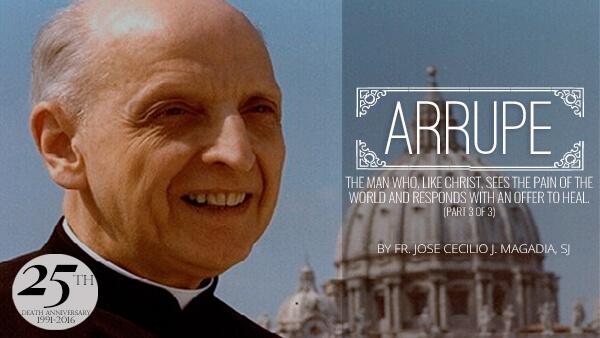


Fr. Jose Cecilio J. Magadia, SJ
*Note: Pedro Arrupe, SJ was the 28th Superior General of the Society of Jesus whose vision and leadership guided the Society in the post-Vatican II world. He died on February 5, 1991. The following reflection was originally part of Fr. Jose Cecilio J. Magadia, SJ’s (former Provincial Superior) points for the Philippine Province Recollection last January 1, 2002, on the occasion of Fr. Arrupe’s 10th death anniversary. This year, as we commemorate Fr. Arrupe’s 25th death anniversary, we are re-posting the reflection in three parts.
Perhaps, the one experience that was to mark Pedro Arrupe’s life took place in Japan, at 8:15 in the morning of August 6, 1945. Arrupe was Master of Novices in Nagatsuka, on the outskirts of Hiroshima. On that fateful morning, they saw that flash, that blinding light, and they felt the blast that created a shower of tiles and bricks and glass. Shortly after, they went out to try to locate where the bomb might have fallen, expecting to see some gaping hole in the ground nearby where a regular B-29 bomb might have landed, only to be surprised to see no sign of explosion. Then they saw the thick smoke rising over the hill. They climbed to get a better view, and there they saw the scene that would change their lives – the decimated city of Hiroshima. Shortly after, they started coming out of the ruins in a steady procession: the survivors who fled the city, bloodied, burned, limbs cut off, blisters that covered whole bodies, some carrying their dead loved ones.
Arrupe says: “We continued looking for some way of entering the city, but it was impossible. We did the only thing that could be done in the presence of such mass slaughter: We fell on our knees and prayed for guidance, as we were destitute of all human help.”
Shortly after, the novitiate was transformed into a hospital, teams to bring the wounded in were organized, relief operations were conducted, and the search for whatever kind of medical aid began. Arrupe spoke of the providential discovery of 15 kilos of boric acid to relieve the burns and save lives. But in the beginning, sometimes, all that could be done was talk to people, listen, give them hope, a hand to hold, a shoulder to cry on.
Years later, Father Arrupe writes a reflection on that day. He says: “History is truly the teacher of life, but only on condition that we know how to interpret her. The fiery furnace of Hiroshima remains as a fixed satellite in the stratosphere, accompanying the earth in its continuous rotation. It is like a sword of Damocles poised constantly over us…. In the midst of so much destruction, confusion and corruption, atomic radiation renders luminous all of humanity as on a huge screen. And through it, reveals the utter uselessness of all that can disappear in a flash; and also reveal the solid substance of all one can dare aspire to of spiritual values.”
After August 6, Arrupe never ceased to be the healer, the medical doctor that he had originally planned to be before he entered the novitiate, but in dimensions that he could never have imagined.
In this, Arrupe provides an antidote to the world – a world which in many parts has chosen to make believe that the suffering is not there, of those who are poor, those who lack freedom, those caught in ethnic conflicts, those preyed on by ideological manipulation, those pushed to the sides by the brutal logic of globalization, the youth, the elderly, women, our indigenous brothers and sisters, our Muslim friends in Mindanao; a world where some have decided to just rationalize the inequalities as an inevitable phase to go through; a world of specialists who have conveniently compartmentalized life, and left the less pleasant segments to those who have a calling for them.
To such a world, Arrupe offers healing, by prayer, by action, and significantly as well, by solidarity, by living the simple life of a simple priest, by not allowing the world’s luxuries to lure him into an easy existence, by his tireless and single-minded dedication to the mission. A companion once said to Arrupe, after months of travel, “Father Arrupe, I am dead tired.” With a smile, Arrupe’s response was: Tiene usted la eternidad para descansar. You have eternity in which to rest.
Today, Arrupe invites us, Jesuits, to look again at our works and our institutions. Do we still seek to heal, or are we just there to get things done? We are asked to look at our apostolates, our structures, our relationships (especially with our lay partners), and ask again whether we Jesuits, as individuals or as communities, are really sources of healing. How so? And how have we been sources of destruction, of pain, of discord, of injustice?
Will Arrupe ever be officially canonized a saint? Maybe, maybe not. But for Don Pedro, the more important thing, I imagine, is not that he is recognized and honored, but that he is seen as Chesterton’s saint, sought for exaggerating what the world neglects and providing the world not what she wants, but what she really really needs, and thus restoring her to sanity.
Part 1: ARRUPE, THE MAN WHO SET HIS HANDS ON THE PLOUGH AND DID NOT LOOK BACK
References:
Roland Jaluag on February 4, 2016 AT 02 am
Thank you Fr. Jojo. Lami kaayo sa kasingkasing.
Comments are closed.